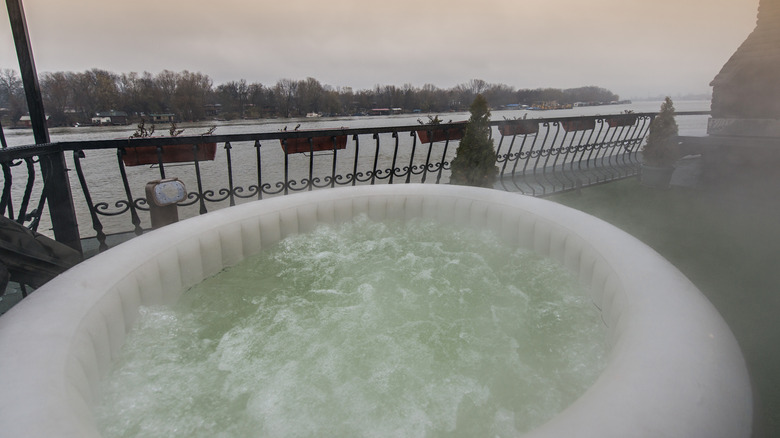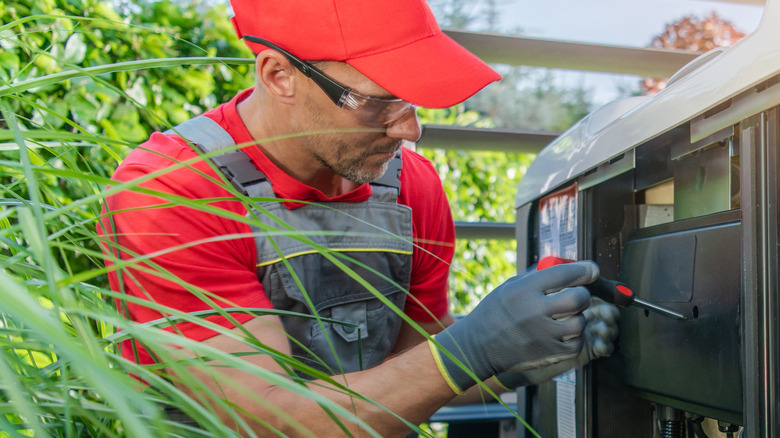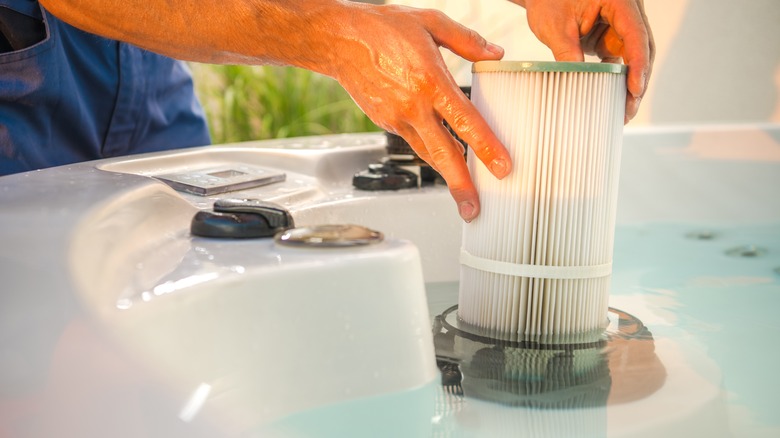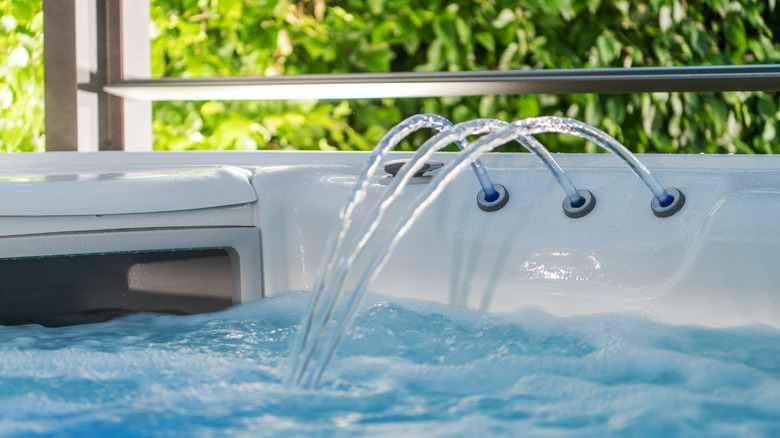You May Want To Think Twice Before Buying That Inflatable Hot Tub
So, you're eyeing that inflatable hot tub, thinking it's the perfect addition to your backyard oasis. It's affordable, easy to set up, and promises to bring the spa experience right to your doorstep. With its inviting bubbles and soothing warmth, it's easy to see why you're tempted to dive right in. But before you take the plunge and hit "buy now," there are some things you might want to know.
From unexpected costs to potential headaches, let's take a closer look at why you might want to think twice before jumping into that inflatable hot tub purchase. Sure, it seems like a dream come true — soaking away your stress under the stars without breaking the bank. But trust us, there's more to these portable spas than meets the eye. So, grab a towel and settle in as we uncover the truth about inflatable hot tubs and whether they're really worth the splash.
They aren't very durable
Unlike their counterparts crafted from durable materials like fiberglass or stainless steel, inflatable hot tub models lack similar structural integrity. Constructed from lightweight PVC or vinyl for ease of transport, this design makes them prone to wear and damage over time. On top of that, because the material is softer, inflatable hot tubs can be punctured or torn easily, contributing to leakage, which compromises their functionality. Even minor incidents, such as accidentally dropping sharp objects or pets scratching the surface, can inflict damage on these portable spas.
Furthermore, the lack of durability extends to the hot tubs' resistance to external elements. Continuous UV exposure from sunlight can lead to the gradual degradation of PVC materials over time, increasing the risk of tears and cracks. Similarly, many inflatable hot tubs struggle to withstand cold weather conditions, which undermines their purpose of providing warmth and relaxation.
Due to this inherent lack of structural integrity, many individuals find themselves replacing their inflatable hot tub within just a few years of its initial setup, much like dealing with a poorly installed fence. While the initial intention may have been to save money, the reality often presents a different outcome. In contrast to hard-side spas with lifespans of 20 years or more, even the highest quality inflatable hot tubs typically last no more than five to seven years before necessitating replacement. Thus, what initially appears as a cost-effective solution may ultimately lead to greater expenses and inconvenience in the long run.
They're not good at retaining heat
Another notable drawback of inflatable hot tubs is their lack of heat-retaining capacity, which can impact the overall user experience and increase operational costs. Unlike traditional hot tubs, which are typically designed with foam insulation or thermal wraps to retain heat efficiently, inflatable models often lack any form of insulation altogether.
This absence of insulation means that inflatable hot tubs typically have thinner walls and less insulation between the water and the surrounding environment compared to their permanent counterparts. As a result, they struggle to maintain a consistent temperature over time, particularly in colder climates or windy conditions where heat loss can occur more rapidly from the water.
As a consequence, the heater in an inflatable hot tub must work harder to compensate for this heat loss and maintain the desired temperature. Owners may find themselves needing to run the heater more frequently or for longer durations, leading to increased energy consumption and, subsequently, higher utility bills. This continuous demand for heating can significantly impact the overall operating costs of the inflatable hot tub, potentially diminishing the initial cost-saving appeal that led to its purchase. Therefore, while inflatable hot tubs may offer convenience and affordability upfront, the long-term implications of their poor heat retaining capacity should be carefully considered by prospective buyers.
They are poor at filtering water
Traditional hot tubs often boast robust filtration systems and surfaces that are easy to clean, but inflatable models may encounter challenges in maintaining water quality and cleanliness due to various factors. Firstly, inflatable hot tubs are typically equipped with smaller and less powerful filtration systems compared to their permanent counterparts. These smaller filters may not effectively remove debris, contaminants, and impurities from the water, resulting in the accumulation of dirt, oils, and bacteria over time. This might make your hot tub water about as safe as water you'd find in the depths of the wilderness.
Consequently, the water in an inflatable hot tub may become cloudy, discolored, or even develop an unpleasant odor if not adequately maintained. The limited filtration capacity of inflatable hot tubs can lead to inadequate water circulation and filtration, allowing pollutants to linger and proliferate. As a result, users may find themselves facing challenges in achieving and maintaining water clarity and hygiene levels that meet their expectations.
Furthermore, inflatable hot tubs' portable nature can pose logistical challenges when it comes to draining, cleaning, and refilling the tub. Unlike permanent hot tubs, which may have dedicated drainage systems and easy access to plumbing, inflatable models may require manual draining and cleaning processes that are more labor-intensive and time-consuming. If not drained or disinfected thoroughly, mold, mildew, and bacteria may grow from pockets of stagnant water.
Their features are limited
Inflatable hot tubs, while convenient and budget-friendly, often come with a trade-off in terms of the features and amenities they offer compared to their permanent counterparts. One notable distinction lies in the absence of hydrotherapy jets in inflatable models, which are a hallmark feature of traditional hot tubs. Hydrotherapy jets provide targeted massage and therapeutic benefits by directing streams of water at specific muscle groups. In contrast, inflatable hot tubs typically lack these jets or may only feature basic air jets, resulting in a less intense massage experience. Even if inflatable hot tubs do incorporate hydrotherapy jets, they often offer limited jet configurations, providing fewer options for adjusting water pressure or direction. Consequently, users may find themselves with a less personalized and versatile spa experience compared to traditional hot tubs.
Furthermore, while not integral to the hot tub experience, customizable lighting options and built-in sound systems are desirable features commonly found in permanent hot tubs. These features allow users to create ambiance and set the mood for relaxation, enhancing the overall experience. However, inflatable hot tubs often lack such amenities, offering minimal or no options for customizable lighting or integrated sound systems. This limitation can impact the aesthetic appeal and atmosphere of the hot tub experience, particularly during evening or nighttime use.
They're not kid-friendly
While inflatable hot tubs may initially appear to be a family-friendly addition to the backyard, there are several reasons why they may not be as suitable for households with children as initially perceived. One significant factor is they typically feature softer and less stable walls compared to traditional hot tubs. This inherent difference poses safety risks, especially for young children, as the sides of inflatable hot tubs may not offer sufficient support for safe entry and exit without assistance. Consequently, there's an increased risk of slips, falls, or accidental submersion, particularly if children are left unsupervised near the hot tub.
Additionally, most inflatable hot tubs have smaller capacities compared to their permanent counterparts, meaning there's limited space available for multiple occupants to enjoy the hot tub together safely. Crowded conditions can heighten the risk of accidents and injuries as occupants navigate within the confined space of the tub. This limitation may also result in discomfort and restricted movement for users, particularly if the hot tub becomes overcrowded with occupants.
When an inflatable hot tub is not in use, it may inadvertently invite curious young children or pets to explore its inviting waters if it is not secured properly. Without proper supervision or security measures in place, this scenario can pose a significant risk of burn injuries.





